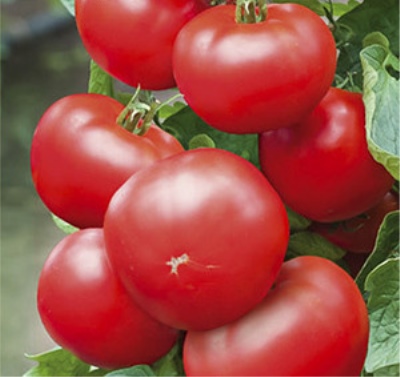
- Authors: V. G. Kachainik, M. N. Gulkin, O. A. Karmanova, S. V. Matyunina, Agrofirma "Aelita" LLC
- Year of approval: 2015
- Category: grade
- Growth type: determinant
- Appointment: fresh consumption, for pickling and preserving
- Ripening period: early
- Ripening time, days: 90-100
- Growing conditions: for open ground, for film greenhouses
- Bush size: dwarf
- Bush height, cm: 35-45
Every year there are more and more varieties of tomatoes suitable for growing in the open field in regions such as Siberia and the Far East. Among them, the tomato Zhorik-glutton showed itself well.
Breeding history
A new variety of tomatoes has been introduced at Agrofirma Aelita LLC, a well-known Russian company for the production and wholesale of seeds. The company applied for the admission of the Zhorik-glutton variety back in October 2014, in 2015 the permit was received. And in March 2016, a patent was obtained for a new variety for a period of 30 years.
4 people worked on the new product:
Kachainik Vladimir Georgievich;
Gulkin Mikhail Nikolaevich;
Karmanova Olga Alekseevna;
Matyunina Svetlana Vladimirovna.
Description of the variety
Tomato Zhorik-glutton belongs to the determinant species intended for growing in the open field and in film greenhouses on a private backyard. But tomatoes grown in an open area have the best taste.
A dwarf bush up to 35-45 cm high with a strong dense stem does not require additional maintenance. Therefore, it can do without garter and pinching.
The height of the plant when grown in the open field makes it easy to cover the planting with covering material in the event of a cold snap or heavy rainfall.
The leaf of the plant is medium in size. The color of the leaf plate is dark green. The inflorescences are intermediate. The first is laid over the 6th sheet, the subsequent ones alternate through the sheet.
Some gardeners use this variety to compact tall tomato plantings.
Zhorik-glutton is an unpretentious plant that easily tolerates a lack of moisture, which is suitable for those gardeners who do not have the opportunity to visit the garden every day.
The main qualities of the fruit
Zhorik-glutton's tomatoes are rounded, slightly flattened on top, with a slight ribbing at the point of attachment to the stalk. The fruits are held quite tightly. There can be up to 6 of them in a bunch.
An unripe tomato berry has a light green color with a spot of a darker shade. In technical ripeness, the fruits are red. Ripening occurs in waves, in one or two waves.
If tomatoes are harvested still unripe, then they are left to ripen in a dark place.
The first fruits can weigh up to 150 g. The next tomatoes weigh less, an average of 90 grams.
The tomato skin is dense, smooth and shiny. The pulp is firm. Keeping quality is good. Suitable for long-term storage and transportation.
The fruit has several seed chambers with a large number of small seeds.
Taste characteristics
In terms of taste, Zhorik-glutton belongs to salad varieties. The taste of the fruit is sour, rich. Good for fresh consumption. And also from the fruits of this variety, you can make tomato juice, pasta and other preparations for the winter.
Ripening and fruiting
Zhorik-glutton belongs to the early maturing varieties. The first fruits can be obtained already on the 90th day from the moment of germination.
Yield
The yield under a film cover is 4.5-5.5 kg / sq. m. In the open field yield per sq. m. m will be slightly less depending on climatic conditions.
The timing of planting seedlings and planting in the ground
Sowing for seedlings in seedling boxes is carried out between March 20 and April 10. Planting in the ground is carried out when the seedlings are 40-60 days old.

Growing tomato seedlings is an extremely important process, because it largely depends on whether the gardener will be able to harvest at all. All aspects must be taken into account, from seedbed preparation to planting in the ground.
Landing scheme
The recommended planting pattern is 50 × 30 cm. These are 5-6 plants per sq. m.

Growing and care
Zhorik-glutton is an undemanding variety, and there are no particular difficulties in caring for him.
The main thing is to properly prepare the soil for planting. To do this, in the fall, it is necessary to apply nitrogen fertilizers on the site where the tomato planting is planned. In the spring, a mineral fertilizer complex is applied.
Seedlings are planted in a prepared area after the onset of stable heat. For the first days, plants need shading and regular, moderate watering. Watering is best done in the morning. To maintain moisture, the soil around the plantings must be mulched. It will also keep weeds from clogging up the plantings.




A plant needs different micronutrients at each stage of growth. All fertilizers can be divided into two groups: mineral and organic. Folk remedies are often used: iodine, yeast, bird droppings, eggshells.
It is important to observe the rate and period of feeding. This also applies to folk remedies and organic fertilizers.
Disease and pest resistance
The new tomato variety is resistant to diseases typical of tomatoes: late blight and rot that affects the roots or tops of the plant.


Resistant to adverse weather conditions
Zhorik-glutton tolerates drought well, continuing to lay ovaries even with a lack of moisture.
Growing regions
The new variety was created for cultivation throughout Russia, including the regions of Siberia, the Far East, northern and North-West.
Review overview
Gardeners appreciated the novelty positively for its unpretentiousness and ease of maintenance. The main complaints arose about the taste of the tomato. Its rather dense structure showed itself poorly in salting. But as the first tomatoes before the later varieties of tomatoes ripen, Zhorik-glutton is very good.

























































































